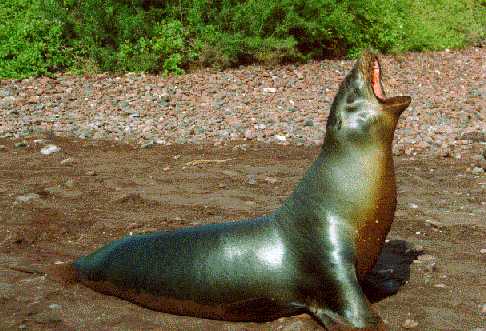 |
|
|
|
|
|
|
|
|
|
|
|
|
|
|
|
|
|
|
|
|
 |
|
|
|
 |
|
|
|
Galápagos Islandsor Colón Archipelago, group of islands in the Pacific Ocean, constituting a province of Ecuador, about 1050 km (about 650 mi) off the western coast of South America. The archipelago consists of 15 large and several hundred small islands lying on or near the equator. The principal islands are Isabela (in English, Albemarle), San Cristóbal (Chatham), San Salvador (James), Santa María (Charles), and Santa Cruz (Indefatigable). The total land area is 7844 sq km (3029 sq mi). |
|
|
|
|
|
 |
|
|
The Land |
|
|
|
|
|
The Galápagos group is noted for its animal life, which includes numerous species found only in the archipelago and different subspecies on separate islands. Unique to the archipelago are six species of giant tortoise (Spanish galápago—thus the islands' name). Other reptiles on the islands include two species of large lizards in the iguana family: a burrowing land lizard and an unusual marine lizard that dives into the ocean for seaweed. The islands contain as many as 85 different species of birds, including flamingos, flightless cormorants, finches, and penguins. Sea lions are numerous, as are many different shore fish. Part of the Galápagos is a wildlife sanctuary. |
|
|
|
|
|
|
 |
|
|
|
Population and Economy |
|
|
|
|
|
The islands have a total population of (1990) 9785, mainly Ecuadorians. The administrative center is Baquerizo Moreno on San Cristóbal. Vegetables, tropical fruits, and coffee are grown. Fishing for tuna, groupers, and spiny lobsters is important. |
|
|
|
|
History |
|
|
| The islands were uninhabited at the time of their exploration by the Spanish in 1535. During the 17th and 18th centuries they were used as a rendezvous by pirates and buccaneers. British and United States warships and whaling vessels landed frequently at the Galápagos in the 19th century. The islands were not settled until after they were annexed by Ecuador in 1832. In 1835 the British naturalist Charles Darwin, traveling aboard HMS Beagle, spent six weeks studying the animal life of the Galápagos. His observations furnished considerable data for his Origin of Species (1859). A satellite tracking station has been on the Galápagos since 1967. |
|
| The islands are volcanic in origin, with level shorelines and mountainous interiors culminating in high central craters, some of which rise more than 1524 m (5000 ft) above sea level. Several volcanoes are active. The islands are fringed with mangroves; farther inland, although still in coastal regions, where little rain falls, the vegetation consists chiefly of thorn trees, cactus, and mesquite. In the uplands, which are exposed to a heavy mist, the flora is more luxuriant. The climate and the temperature of the waters surrounding the islands are modified by the cold Humboldt Current from the Antarctic. |







